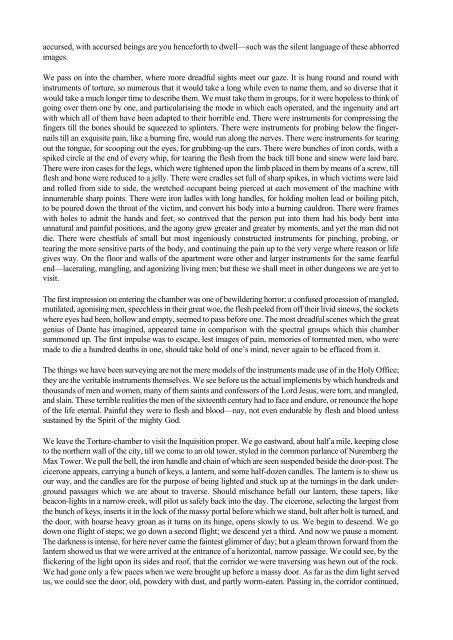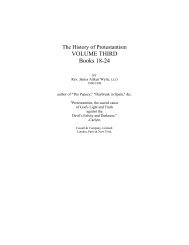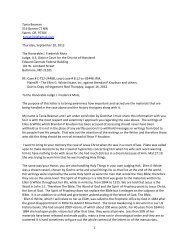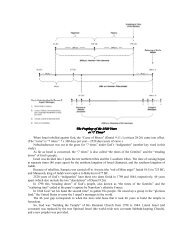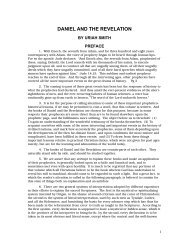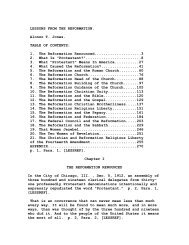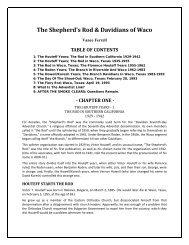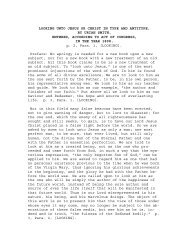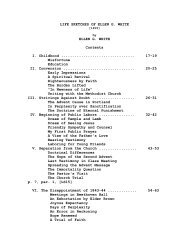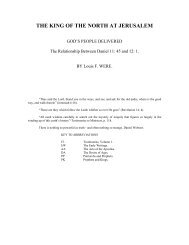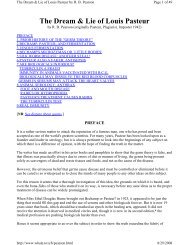History of Jesuits
History of Jesuits
History of Jesuits
Create successful ePaper yourself
Turn your PDF publications into a flip-book with our unique Google optimized e-Paper software.
accursed, with accursed beings are you henceforth to dwell—such was the silent language <strong>of</strong> these abhorred<br />
images.<br />
We pass on into the chamber, where more dreadful sights meet our gaze. It is hung round and round with<br />
instruments <strong>of</strong> torture, so numerous that it would take a long while even to name them, and so diverse that it<br />
would take a much longer time to describe them. We must take them in groups, for it were hopeless to think <strong>of</strong><br />
going over them one by one, and particularising the mode in which each operated, and the ingenuity and art<br />
with which all <strong>of</strong> them have been adapted to their horrible end. There were instruments for compressing the<br />
fingers till the bones should be squeezed to splinters. There were instruments for probing below the fingernails<br />
till an exquisite pain, like a burning fire, would run along the nerves. There were instruments for tearing<br />
out the tongue, for scooping out the eyes, for grubbing-up the ears. There were bunches <strong>of</strong> iron cords, with a<br />
spiked circle at the end <strong>of</strong> every whip, for tearing the flesh from the back till bone and sinew were laid bare.<br />
There were iron cases for the legs, which were tightened upon the limb placed in them by means <strong>of</strong> a screw, till<br />
flesh and bone were reduced to a jelly. There were cradles set full <strong>of</strong> sharp spikes, in which victims were laid<br />
and rolled from side to side, the wretched occupant being pierced at each movement <strong>of</strong> the machine with<br />
innumerable sharp points. There were iron ladles with long handles, for holding molten lead or boiling pitch,<br />
to be poured down the throat <strong>of</strong> the victim, and convert his body into a burning cauldron. There were frames<br />
with holes to admit the hands and feet, so contrived that the person put into them had his body bent into<br />
unnatural and painful positions, and the agony grew greater and greater by moments, and yet the man did not<br />
die. There were chestfuls <strong>of</strong> small but most ingeniously constructed instruments for pinching, probing, or<br />
tearing the more sensitive parts <strong>of</strong> the body, and continuing the pain up to the very verge where reason or life<br />
gives way. On the floor and walls <strong>of</strong> the apartment were other and larger instruments for the same fearful<br />
end—lacerating, mangling, and agonizing living men; but these we shall meet in other dungeons we are yet to<br />
visit.<br />
The first impression on entering the chamber was one <strong>of</strong> bewildering horror; a confused procession <strong>of</strong> mangled,<br />
mutilated, agonising men, speechless in their great woe, the flesh peeled from <strong>of</strong>f their livid sinews, the sockets<br />
where eyes had been, hollow and empty, seemed to pass before one. The most dreadful scenes which the great<br />
genius <strong>of</strong> Dante has imagined, appeared tame in comparison with the spectral groups which this chamber<br />
summoned up. The first impulse was to escape, lest images <strong>of</strong> pain, memories <strong>of</strong> tormented men, who were<br />
made to die a hundred deaths in one, should take hold <strong>of</strong> one’s mind, never again to be effaced from it.<br />
The things we have been surveying are not the mere models <strong>of</strong> the instruments made use <strong>of</strong> in the Holy Office;<br />
they are the veritable instruments themselves. We see before us the actual implements by which hundreds and<br />
thousands <strong>of</strong> men and women, many <strong>of</strong> them saints and confessors <strong>of</strong> the Lord Jesus, were torn, and mangled,<br />
and slain. These terrible realities the men <strong>of</strong> the sixteenth century had to face and endure, or renounce the hope<br />
<strong>of</strong> the life eternal. Painful they were to flesh and blood—nay, not even endurable by flesh and blood unless<br />
sustained by the Spirit <strong>of</strong> the mighty God.<br />
We leave the Torture-chamber to visit the Inquisition proper. We go eastward, about half a mile, keeping close<br />
to the northern wall <strong>of</strong> the city, till we come to an old tower, styled in the common parlance <strong>of</strong> Nuremberg the<br />
Max Tower. We pull the bell, the iron handle and chain <strong>of</strong> which are seen suspended beside the door-post. The<br />
cicerone appears, carrying a bunch <strong>of</strong> keys, a lantern, and some half-dozen candles. The lantern is to show us<br />
our way, and the candles are for the purpose <strong>of</strong> being lighted and stuck up at the turnings in the dark underground<br />
passages which we are about to traverse. Should mischance befall our lantern, these tapers, like<br />
beacon-lights in a narrow creek, will pilot us safely back into the day. The cicerone, selecting the largest from<br />
the bunch <strong>of</strong> keys, inserts it in the lock <strong>of</strong> the massy portal before which we stand, bolt after bolt is turned, and<br />
the door, with hoarse heavy groan as it turns on its hinge, opens slowly to us. We begin to descend. We go<br />
down one flight <strong>of</strong> steps; we go down a second flight; we descend yet a third. And now we pause a moment.<br />
The darkness is intense, for here never came the faintest glimmer <strong>of</strong> day; but a gleam thrown forward from the<br />
lantern showed us that we were arrived at the entrance <strong>of</strong> a horizontal, narrow passage. We could see, by the<br />
flickering <strong>of</strong> the light upon its sides and ro<strong>of</strong>, that the corridor we were traversing was hewn out <strong>of</strong> the rock.<br />
We had gone only a few paces when we were brought up before a massy door. As far as the dim light served<br />
us, we could see the door, old, powdery with dust, and partly worm-eaten. Passing in, the corridor continued,


